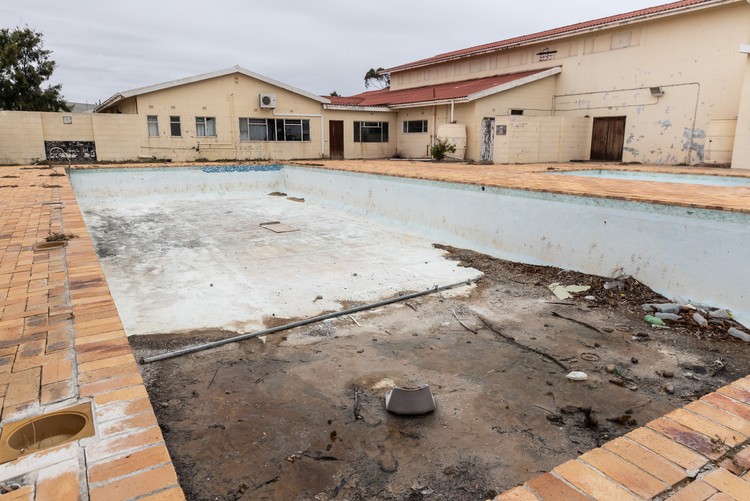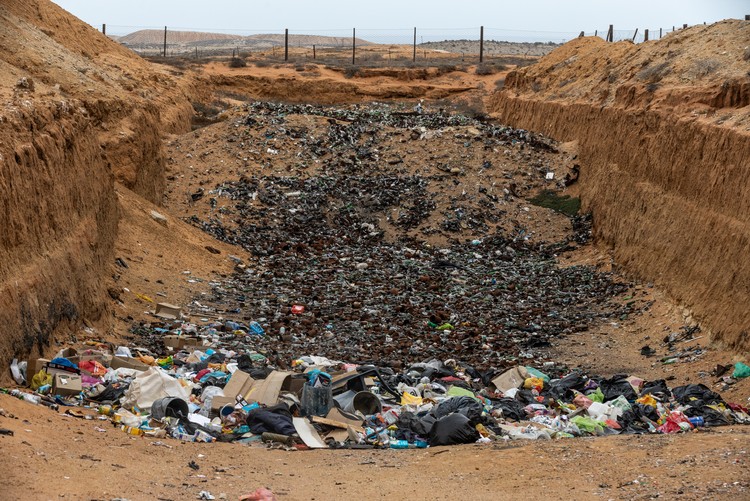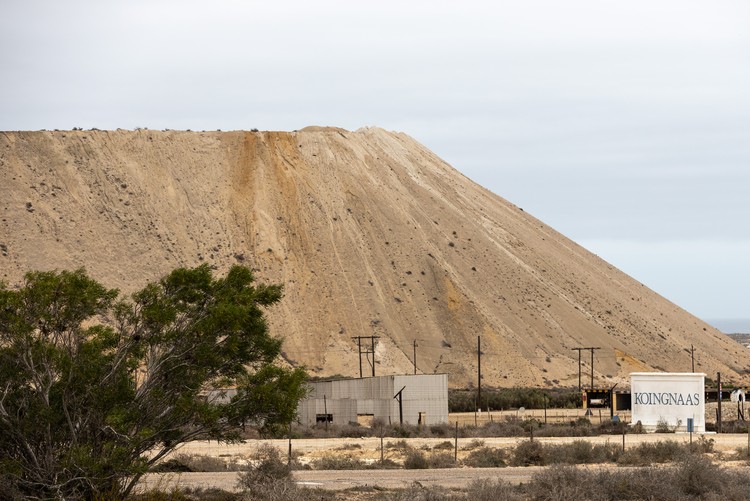Remote Namaqualand diamond town battles dust and neglect
Mine told to fix the pollution problem
Municipal buildings in Koingnaas, including the public swimming pool area, have fallen into disrepair. Photos: Ashraf Hendricks
A diamond mine in the remote Namaqualand town of Koingnaas has been issued with a compliance notice by the Northern Cape Department of Agriculture, Environmental Affairs, Rural Development and Land Reform for dust pollution from the dried up tailings dam at its mine.
Residents of former De Beers mining town Koingnaas have complained about the dust pollution from the nearby West Coast Resources mine for several years. West Coast Resources, which was acquired by Trans Hex in 2017, has been in difficulties and is currently under business rescue.
Koingnaas, on the West Coast, is about 100km north-west of Garies and 65 km south of Kleinsee. Established and run by De Beers, the town was handed over to the Kamiesberg municipality partially in 2010 and fully in 2016.
It houses a few hundred residents and since the handover, municipal services have degenerated, according to the residents.
Rubbish is rarely removed and when it is, it’s dumped in unlicensed waste disposal sites right outside of town; the roads, sewage system and municipal buildings have fallen into disrepair; and the water supply is frequently interrupted.
One of a few dump sites around Koingnaas, some of which are unlicenced waste disposal sites.
A local ratepayers’ association called Koingnaas Belastingbetalersvereniging (KBBV) and the Kamiesberg Municipality were in the Kimberley High Court at the end of last year after the KBBV wanted to step in and service the roads and infrastructure itself. The court interdicted the association from “taking control of the municipal infrastructure”.
The ratepayers’ association argued that since 2016 their small town had “degenerated to the point of the community receiving little or no municipal services”.
Dust pollution from the old De Beers tailings dam has been an issue for several years. Because the dam has dried, “the wind blows the dust over the whole town”. “You can close your windows, but the dust will find a way in,” said a resident who wished to not be named.
It affects people’s sinuses and eyes and it coats the plants in their gardens.
Another Koingnaas resident, Piet Claase, said, “The mining company must take responsibility for the mine that it took over … They must be held responsible.”
The West Coast Resources mine has been issued with a compliance notice for the dust blowing over the town of Koingnaas.
David Khakhane of the Department of Agriculture, Environmental Affairs, Rural Development and Land Reform told GroundUp that, along with a compliance notice, they’ve sent recommendations to the Kamiesberg Municipality and West Coast Resources about the dust pollution from the slimes dam.
Khakhane said that it was “quite a unique situation” and “a number of different interventions must come to the table for us to be able to adequately address the situation”.
Currently, the department has recommended placing large tyres “to curb some of the dust” but this would be a “logistical nightmare”, because they would need about 200 tyres transported by trucks. The roads leading to Koingnaas are mostly gravel roads.
Previously, netting was used to cover the slimes dam, as well as pebbles, which did not solve the problems, according to Khakhane.
On the road from Kleinsee to Koingnaas, towns on the West Coast of Namaqualand.
The dust issue has also been raised in Parliament for a number of years by DA MP Veronica Van Dyk.
On 10 March 2023, asked about the dust pollution “affecting the quality of life of the residents”, the Department of Mineral Resources and Energy (DMRE) said that rehabilitation was “on hold” because West Coast Resources was in business rescue.
The DMRE also said it would conduct regular inspections to ensure compliance with the environmental authorisation.
The last inspection was done on 6 December 2023 with officials from the Council for GeoScience, the DMRE said, responding to GroundUp. During this inspection they “did not observe any dust pollution within the area” but admitted that this could be due to the “timing and season” of the inspection. The DMRE said rehabilitation was now taking place and that West Coast Resources had indicated that it is busy resolving the issue with the community.
A Koingnaas resident GroundUp spoke to said that they recently had a promising meeting with West Coast Resources about its action plan to curb the dust pollution with nets and topsoil spread at strategic places. The resident said they are worried the tyre method, as recommended by the provincial department, will cause more pollution.
Trans Hex did not respond to GroundUp queries. The Kamiesberg municipality also did not respond to GroundUp queries despite many follow-ups.
The entry to the old De Beers town of Koingnaas.
Support independent journalism
Donate using Payfast

Don't miss out on the latest news
We respect your privacy, and promise we won't spam you.
Next: Refugee and former car guard graduates with a PhD
Previous: Western Cape separatist loses complaint against Daily Maverick
© 2024 GroundUp. This article is licensed under a Creative Commons Attribution-NoDerivatives 4.0 International License.
You may republish this article, so long as you credit the authors and GroundUp, and do not change the text. Please include a link back to the original article.
We put an invisible pixel in the article so that we can count traffic to republishers. All analytics tools are solely on our servers. We do not give our logs to any third party. Logs are deleted after two weeks. We do not use any IP address identifying information except to count regional traffic. We are solely interested in counting hits, not tracking users. If you republish, please do not delete the invisible pixel.





